Hyphenated Electronic Nose Technique for Aroma Analysis of Foods and Beverages
LCGC Europe
Mass spectrometry-based electronic nose technology (MS-nose technology) is a fast hyphenated technique for digital odour characterization of food and beverage products.
Innovative food companies have shown an increased interest in developing fast analytical techniques to characterize the flavour/aroma of food products that compare well with sensory analysis by human taste panels. Fast sensory-directed techniques can rely on electronic nose (e-nose) or electronic tongue (e-tongue) technology. Both technologies have been developed by research laboratories and commercial companies during the past 10 years, but still have a long way to go before they are applied in an industrial environment. As the human nose is involved in 80–90% of the total flavour perception, digital odour characterization using electronic nose technology can be used for fast classification of food products in good accordance with sensory analysis.
History of Electronic Nose Technology
Conventional techniques for assessing flavour quality, such as sensory analysis and GC–MS, are often too time-consuming and labour-intensive to be used as quality control (QC) methods within the food industry. The ultimate challenge is to develop fast analytical procedures resulting in classifications of food products that correlate well with sensory panel data. Electronic nose technology seemed to be an ideal approach when introduced a few decades ago.1 In the 1990s an 'electronic nose' was defined by Gardner and Bartlett as "an instrument, which comprises an array of electronic chemical sensors with partial specificity and an appropriate pattern recognition system, capable of recognizing simple or complex odours."2
These systems generate a sensor array response to a complete volatile pattern, without separating the aroma compounds and use pattern recognition software for data processing. In the same way that humans use the receptors in the nose to smell a mixture of volatiles and the brain to analyse the data, e-nose systems use sensors and a data processor with pattern recognition software for classification of products.3 Currently, two electronic nose technologies exist on the technology market: conventional electronic nose technology based on gas sensors and the more recently developed electronic nose technology based on MS. It is clear that with artificial olfaction systems the operating principle, the number of sensors and their sensitivity and selectivity is very different from the human perception. The indication of such an analytical system as an 'e-nose' system, is perhaps more appropriate when the pattern recognition data interpretation is considered. As is the case with human perception these systems deliver a comparative rather than a qualitative/quantitative composition of the volatile mixture sent to the sensors.
Gas Sensor-based E-noses Versus MS-based E-noses
Conventional electronic noses are based on gas sensors. In the sensor array of a gas sensor-based electronic nose the volatiles interact physically and/or chemically and a dynamic equilibrium develops by adsorption and desorption at the sensor surface. Different types of gas sensors have been used in literature: metal oxide semiconductors (MOS), metal oxide semiconductor field effect transistors (MOSFET), surface acoustic wave sensors (SAW), quartz microbalance sensors (QMB), conducting organic polymers (CP).4–5 Usually 6–12 gas sensors from the same type but with different response characteristics are used in a multi-sensor array.
Although numerous commercial systems have been introduced and were claimed to be able to replace time-intensive sensory panels, in our laboratory we were not really convinced of the value of these techniques for objective characterization of aroma characters in food products. In our opinion the conventional e-nose technology is a 'black box' system and one does not really know what the signals respond to and what the instrument is really measuring. The speed of the systems is attractive, but they would, in most cases, not replace but complement sensory methods and traditional analytical techniques, such as GC–MS profiling.
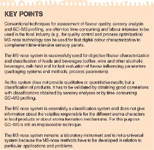
KEY POINTS
Furthermore, the first generation of instruments used static headspace to deliver the volatiles to the sensors. Aroma chemists know that this aroma isolation technique is certainly not sensitive enough to deal with the complexity of aroma compounds in food materials and with the odour potency of specific compounds. Also, the literature claimed that the gas sensor array systems have not generally lived up to expectations. Problems with drift, instability as a result of humidity (water vapour) or carbon dioxide, the need for frequent calibration, sensor poisoning and poor sensor-to-sensor and instrument-to-instrument reproducibility (transportability) are some of the major disadvantages.6
More recently, a new generation of e-nose systems based on mass spectrometry was introduced, also referred to as MS-based electronic nose or MS-nose technology and mass fingerprinting or MS-fingerprinting. This e-nose technology was certainly more compatible with the basic knowledge of aroma chemists concerning the complexity and specificity of odour perception and the relationship with food flavour. In our opinion, from a theoretical point of view, the combination of a mass spectrometer and pattern recognition as a fast method to classify food products in relation to their flavour characters should be much more successful compared with the e-nose approach using gas sensor arrays.
The majority of the e-nose papers in the field of food analysis deal with conventional e-nose technology based on gas sensors. Only a small part of the literature is dedicated to the application of MS-based electronic nose technology.5–11
Configuration of the MS-based Electronic Nose
The MS-nose system was a hyphenated instrument consisting of a sample preparation autosampler (MultiPurposeSampler or MPS-2, Gerstel, Mülheim an der Ruhr, Germany), a 6890/5973 GC–MS system (Agilent Technologies, Palo Alto, California, USA) and a workstation with instrument software (Agilent Technologies) and Pirouette pattern recognition software for data processing (Infometrix, Woodinville, Washington, USA).
Fully automated sample preparation module for fast aroma isolation
The first module of the mass spectrometry-based electronic nose (MS-nose) configuration was a fully automated sample preparation unit for fast isolation of volatiles from a matrix. Although commercially available e-nose systems generally used static headspace (S-HS) as the isolation technique, some e-nose applications can require other isolation techniques for certain crucial aroma compounds because with S-HS the analyte range is often restricted to high-volatile compounds. The autosampler chosen can perform fully automated isolation of volatiles using both static headspace (S-HS) and solid-phase microextraction (SPME). If necessary, the hyphenated configuration can be expanded with a thermal desorption unit, which opens possibilities for other aroma isolation techniques such as direct thermal desorption (DTD), stir-bar sorptive extraction (SBSE), headspace sorptive extraction (HSSE) and dynamic-headspace (D-HS).
MS-based sensing system
The basis of the MS-nose instrument was a quadrupole mass spectrometer (MS with a classical split/splitless injector). Consequently, this hyphenated configuration can be used for both GC–MS and MS-nose applications, which is especially useful in an R&D environment.
For using the hyphenated configuration in the MS-nose mode two options were evaluated. Firstly, the GC column chosen (HP-PONA cross-linked methyl silicone; 50 m × 0.2 mm i.d., 0.5 μm film thickness; Agilent Technologies) can be changed by a deactivated fused-silica capillary without any stationary phase (e.g., 1 m × 100 μm i.d.), which can be used as a transfer line from the GC injector to the MS sensing system. Secondly, the GC column can be held continuously at high temperature (e.g., 250 °C) to minimize the restriction of the volatiles, transferring the isolated aroma compounds directly to the mass spectrometer without chromatographic separation. The configuration with the GC column at high temperature had the advantage of high flexibility because with the same configuration both GC–MS mode and MS-nose mode can be applied and it was quite easy to switch from one mode to another. For this reason the latter flexible configuration with the GC column at high temperature was used.
Workstation with specific software
The third module was a workstation with instrument software for data acquisition and chemometrical software for data analysis. The basic data acquisition software of the GC–MS instrument was extended with specific ChemSensor software. This software allowed the conversion of a total mass spectrum to a so-called 'mass fingerprint'. Pirouette pattern recognition enabled on-line data processing of the generated mass fingerprints. Within the chemometrical software package exploratory algorithms (e.g., hierarchical cluster analysis or HCA, principal component analysis or PCA) were used to explore the MS-nose data, whereas classification algorithms (e.g., soft independent modelling of class analogy or SIMCA, k-nearest neighbours or KNN) were used to classify samples.
MS-based Electronic Nose Analysis
After the fast isolation of the aroma compounds from a food matrix the isolated volatiles were directly introduced into the source of the mass spectrometer without separation. The mass spectrometer generated a total mass spectrum representing the summation of the mass spectra of all isolated volatiles sent to the MS source. Consequently, the total mass spectrum was transferred using software to a mass fingerprint. Mass fingerprints of different products or replicates of the same product were processed on-line by pattern recognition software. The different steps in an MS-nose analysis are summarized in Figure 1.
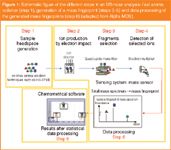
Figure 1
Fast aroma isolation of volatiles
One of the most important steps in an MS-nose analysis is the fast isolation of volatiles from the food matrix. Static headspace (S-HS), commonly used in commercial e-nose systems, is often not appropriate for applications in the food field and for objective characterization of flavour characters in food, as might be expected from basic aroma chemistry knowledge. With S-HS the analyte range is restricted to high-volatile compounds. Flavour characterization often requires isolation of crucial less volatile compounds. Therefore, other recently developed solvent-free sorptive techniques, such as solid-phase microextraction (SPME) and stir-bar sorptive extraction (SBSE), can be explored for fast aroma isolation in combination with mass fingerprinting.
Generation of mass fingerprints
The sensing system of the MS-based electronic nose was a quadrupole mass spectrometer, which was a part of a classical GC–MS instrument as the mass sensor was coupled to a gas chromatograph in the presented hyphenated configuration. As mentioned before, this hyphenated configuration could be used in two operation modes: GC–MS mode and MS-nose mode, which made this instrument very useful for R&D purposes.
In the MS-nose mode the GC column was continuously held at 250 °C and the isolated volatiles were directly sent to the quadrupole mass spectrometer without prior chromatographic separation. Helium was used as carrier gas (1 mL/min). With the high temperature of the GC column and the flow conditions the transfer of the volatiles to the MS sensing system was achieved in only 5 min. The classical split/splitless injector and the transfer lines were maintained at 250 °C and 280 °C, respectively. Electron impact was used with electron energies of 70 eV. The total ion current was recorded in the mass range from 40–230 amu (scan mode) and the run time was 5.0 min. The injection profile recorded from the mass spectrometer was a 'total ion chromatogram' (TIC) with only one broad peak of 'co-eluting' volatiles (Figure 2). The electron impact mass spectrum of the injection peak corresponded to the total mass spectrum of all isolated volatile compounds. The obtained total mass spectrum resulted from the fragmentation of all aroma compounds that were introduced into the ionization chamber of the mass spectrometer during the run time.
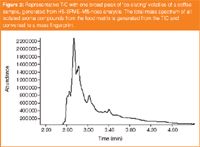
Figure 2
From the 'total ion chromatogram' (TIC) of a sample a total mass spectrum of all isolated aroma compounds was obtained and converted by the software to a composite mass fingerprint. Figure 3 shows the conversion of a total mass spectrum to a so-called mass fingerprint, which can be visualized in a line plot format with, in the X-axis, the ion masses (m/z) of the mass fragments of all isolated aroma compounds within the mass range of the sensing system and, in the Y-axis, the corresponding ion abundances of the mass fragments. Hence, it is possible to relate certain m/z values in a mass fingerprint to typical mass fragments of an aroma compound or a class of aroma compounds. This implies that a mass fingerprint contains chemical information about the analysed sample, which is one of the major advantages of MS-nose technology in comparison with conventional electronic nose technology based on gas sensors.
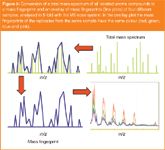
Figure 3
Data analysis of mass fingerprints
Chemometrics play an important role in the data processing of MS-nose data. Chemometry is the field of efficiently extracting easily interpretable and meaningful information from complex multivariate (chemical) data sets using tools of statistics and mathematics. The presented MS-nose system used the chemometrical software that applies different algorithms for exploratory data analysis, classification analysis and regression analysis.12
The goal of exploratory data analysis is to recognize patterns of association in multivariate data sets and to perform a quality check on the data, exposing possible outliers (unusual samples). The exploratory algorithms are designed to reduce large and complex data sets into a set of best views of the data with minimal loss of information. These views provide insight into the structure and correlations that exist among the samples and variables in a data set. Mostly used in this perspective as unsupervised pattern recognition techniques are principal component analysis (PCA) and hierarchical cluster analysis (HCA). These exploratory algorithms indicate if the data are appropriate for the set-up of classification models.
If there is sufficient discriminating power in the generated data, a model can be developed to predict a property of interest (e.g., categorical or continuous property). In the case of digital odour characterization the property of interest is generally a discrete category assignment (e.g., variety 1 or variety 2 or variety 3; good or bad). Then classification analysis is the appropriate approach. After method development classification/discrimination of the data, also known as supervised pattern recognition, is performed. Classification analysis allows to build models by analysing training samples belonging to a priori known classes. The obtained models allow assignment of unknown samples to a certain class. Soft independent modelling of class analogy (SIMCA) and k-nearest neighbours (KNN) are classification algorithms mostly used for this purpose.
All MS-nose data from one analysis run or sequence generated a full data set (.DAT file) which could be visualized as an overlay of mass fingerprints (Figure 3) or as a data table. Exploratory and classification algorithms could be applied on full data sets or on well-defined sub-data sets or exclusion sets.
Normalization. All generated MS-nose data were normalized by averaging all ion abundances to 100.0. Normalization was performed by dividing each data value by a normalization factor. Normalized MS-nose data from an analysis run can be visualized as an overlay of mass fingerprints (Figure 3) or as a data matrix with, in the rows, the samples or replicates and, in the columns, the ion abundances of all mass fragments within the mass range of the sensing system (e.g., 40–230 amu).
Feature extraction. After normalization of the MS-nose data feature extraction was performed to eliminate data noise. To improve the data quality some ion masses (m/z) were eliminated from the data sets: m/z = 40 (argon); m/z = 44 (CO2); m/z = 73, 133, 147 and 177 (column bleeding); m/z = 75 and 173 (PDMS fibre); and in some cases m/z = 149 (phthalate). Especially column bleeding could lead to the presence of a 'background'. Without elimination of the features attributed to column bleeding (m/z = 73, 133, 147 and 177), column bleeding would effect pattern recognition. With static headspace (S-HS) no isolation of high-boiling aroma compounds resulted in feature elimination of ion masses with high m/z values (e.g., 141–230 amu) and consequently acceleration of the computational time.
Elimination of outliers. Outliers are extreme observations that are situated outside the general pattern formed by other observations. The presence of outliers could seriously affect the performance of a pattern recognition algorithm. Sometimes visualization of a data set in line plots might indicate anomalous values. Also overlaying line plots of all samples in a data set could give a quick indication of samples that might be outliers. Furthermore, score plots (PCA) or class projection plots (SIMCA) could highlight the presence of possible outliers, especially if replicates of the same sample were not all clustered together. For clear identification of outliers the MS-nose data were generally subjected to so-called outlier diagnostics within the PCA or SIMCA algorithms. Depending on the selected number of factors in PCA or SIMCA processing more or less outlier samples could be diagnosed. After the identification of outliers by outlier diagnostics 'out of spec' samples were excluded from the original data set, generating a so-called exclusion set.
After normalization, feature selection and elimination of outliers the MS-nose data were subjected to exploratory data analysis, using unsupervised pattern recognition techniques (e.g., hierarchical cluster analysis or HCA, principal component analysis or PCA) or classification analysis, using supervised pattern recognition techniques (e.g., soft independent modelling of class analogy or SIMCA, k-nearest neighbours or KNN).13–15
Validation for Flavour Quality Assessment
The major advantages of MS-based electronic nose technology compared with conventional electronic nose technology based on gas sensors are listed below:6,16
Proven technology. MS-nose technology is based on the proven technology of quadrupole mass spectrometry, which has been used for decades now and has become one of the most important and universally used detection and identification tools for analytical instrumentation.
Chemical information. One of the major advantages is the chemical information that is generated from MS-nose data. Mass fingerprints and their chemometrical data processing can allow correlation with classical GC–MS data. Certain m/z values can be related to typical mass fragments of some aroma compounds or classes of aroma compounds. Especially aroma compounds with specific fragmentation patterns and unique mass fragments, which are not common for other aroma constituents, can contribute to a greater extent to discrimination of samples.
Stability. In contrast to gas sensor systems, which suffer from long-term drift and significant humidity and temperature dependence, MS-based e-noses are more stable and reliable. MS-noses are unaffected by ambient humidity or ambient temperature fluctuations. No sensor poisoning as a result of the presence of alcohols occurs as is the case with some traditional gas sensors. The influence from potential interference compounds may also be reduced or eliminated by excluding the associated 'sensor' responses (m/z values) of interfering compounds [e.g., CO2 (m/z = 44), column bleeding (m/z = 73, 133, 147 and 177), ...].
Universal sensing system. The mass spectrometric sensing system is universal and can be used for all kinds of samples, without any restrictions, because the sensing system responds to all volatiles. Multiple applications can be performed on the same system. Limitation of the applicability of the MS-nose system for aroma characterization of food products is related to the volatile delivery system. Because, depending on the nature of the food matrix, fast aroma isolation can be performed in a more or less reproducible way.
Wide data range. The data range is not restricted to the number of sensors in the sensor array, but is dependent on the mass range of the mass spectrometer (e.g., 2–800 amu). Each m/z value is treated as the equivalent of a sensor response from the conventional electronic noses. This means that there are potentially several hundred 'sensors'.
Linearity. The MS sensing system responds linearly over four orders of magnitude. In contrast, gas sensors have small linear ranges, typically no greater than two orders of magnitude.
Reproducibility. Good reproducibility of the MS-nose data was demonstrated by the small ellipses for the confidence intervals (95%) of the different classes in the SIMCA projections plot and by the identification of only a few outliers (1 or 2) in the data sets.
Robustness, reliability and stability were considered as the major advantages of MS-based electronic nose compared with gas sensor arrays.
Applications of MS-nose Technology in Food Analysis
MS-nose technology can be used for many purposes in the field of food analysis:
- Quality control/quality assessment (QC/QA).
- Classification, differentiation, origin characterization.
- Authentication, detection of fraud (adulteration, dilution or substitution).
- Objective sensory evaluation.
- Product stability and consistency.
- Shelf life experiments (e.g., optimal harvest date, spoilage, ...).
- Detection of defects (off-flavours, taints, contaminants, ...).
- Process optimization.
- Sensory benchmarking.
Some MS-nose applications using the described hyphenated system were preformed for the food industry. The MS-nose system was successfully used for fast digital odour characterization of coffee (roasted coffee powder) and wine.17–24
One of the drawbacks of the system is the expensive instrumentation needed for its performance. In that way, the MS-nose system will essentially remain a system for service laboratories or will be only attainable for larger and innovative food companies. It should also be understood that the mass fingerprinting system is not a universal system and it has to be remembered that it will be necessary to adapt procedures in relation to the different food matrices.
In that respect, fast isolation of volatiles from the food matrix will remain a crucial aspect. Difficulties may be expected when dealing with fatty materials (e.g., cheese), because of the restricted release of the aroma compounds from the food matrix. Also, the lack of flavour stability of products during analysis may be a major drawback and could lead to inconsistent mass fingerprints for replicate samples placed in randomized order in the sampling tray of the sample preparation unit (e.g., fruit juice). Some of these drawbacks could be overcome by adapting the sampling procedures. Despite these drawbacks several successful, but confidential applications, were performed in our laboratory for different food, food ingredient and food packaging companies.
Conclusions
MS-based electronic nose technology has a huge advantage over conventional e-nose systems as a rapid screening technique for aroma analysis of food products. Because of its relation with GC–MS, which allows more details on the volatile composition and the relation with flavour characters, MS-nose technology also obtains chemical information (mass fingerprints) from the samples. A crucial aspect is the applicability of fast aroma isolation techniques, such as solid-phase microextraction (SPME). Compared with the classical analytical approach for aroma analysis, based on cumbersome and laborious isolation techniques in combination with capillary GC–MS and off-line multivariate statistics, an important time gain can be obtained (approximately 25 times faster). The benefits of MS-nose technology will have to be demonstrated by performing other successful applications for the food and packaging industry.
Acknowledgments
This work was supported by the Institute for the Promotion of Innovation by Science and Technology in Flanders (IWT-Flanders).
Inge Dirinck has been working at the Laboratory of Toxicology at Ghent University, Belgium after graduating in pharmaceutical sciences. Since 1999 she has been a researcher at the Laboratory for Flavour Research at the Catholic University College in Ghent. She obtained her PhD title in February 2009 at the Faculty of Pharmaceutical Sciences of Ghent University.
Isabelle Van Leuven is, together with Inge Dirinck, technological adviser of SENSTECH within a Technological Services Project of the Institute for the Promotion of Innovation by Science and Technology in Flanders (IWT-Flanders). This project aims to stimulate product and process innovations in the food and packaging industry.
Patrick Dirinck is professor of organic chemistry at the Catholic University College Ghent and head of the Laboratory for Flavour Research.
References
1. K. Persaud and G. Dodd, Nature, 299, 352–355 (1982).
2. J.W. Gardner and P.N. Bartlett, Sens. Actuators B, 18, 211–220 (1994).
3. T.C. Pearce et al., Handbook of Machine Olfaction — Electronic Nose Technology (Wiley-VCH Verlag, Weinheim, 2003).
4. T. Aishima, J. Agric. Food Chem., 39, 752–756 (1991).
5. D. Hodgins, in Techniques for Analyzing Food Aroma, R. Marsili, Ed. (Marcel Dekker, New York, 1997), p. 331–371.
6. R. Marsili, in Flavor, Fragrance and Odor Analysis, R. Marsili, Ed. (Marcel Dekker, New York, 2002), p. 349–376.
7. P.N. Bartlett, J.M. Elliott and J.W. Gardner, Food Technol., 51, 44–48 (1997).
8. E. Schaller, J.-O. Bosset and F. Escher, Lebensm. Wiss. Technol., 31, 305–316 (1998).
9. C. Di Natale et al., Sens. Actuators B, 44, 521–526 (1997).
10. C. Di Natale, R. Paolesse and A. D'Amico, in Handbook of Machine Olfaction — Electronic Nose Technology, T.C. Pearce, S.S. Schiffman, H.T. Nagle and J.W. Gardner, Eds., (Wiley-VCH Verlag, Weinheim), p. 505–524.
11. C. Pérès et al., Trends Anal. Chem., 22, 858–866 (2003).
12. Infometrix, Pirouette Manual (2001).
13. Infometrix, Chemometrics Technical Note (1993).
14. D.L. Massart et al., Handbook of Chemometrics and Qualimetrics — Part A, Elsevier, Amsterdam, 1997.
15. B.G.M. Vandeginste et al., Handbook of Chemometrics and Qualimetrics — Part B, Elsevier, Amsterdam, 1998.
16. Infometrix, Application Note Electronic Nose Instrumentation (1999).
17. I. Dirinck, I. Van Leuven and P. Dirinck, in Flavour Research at the Dawn of the Twenty-First Century, J.L. Le Quéré, P.X. Etiévant, Eds. (Lavoisier, Editions Tec & Doc, Paris, 2003), p. 572–575.
18. I. Dirinck et al., in Proceedings of the 9th International Symposium on Olfaction and Electronic Nose (ISOEN'02), A. D'Amico, C. Di Natale, Eds. (Aracne, Rome, 2003), p. 215–219.
19. I. Dirinck, I. Van Leuven and P. Dirinck, in State-of-the-Art in Flavour Chemistry and Biology, T. Hofmann, M. Rothe and P. Schieberle, Eds. (Deutsche Forschungsanhalt für Lebensmittelchemie, Garching, 2005), p. 98–106.
20. I. Dirinck, I. Van Leuven and P. Dirinck, in Flavour Science: Recent Advances and Trends (Book Series Developments in Food Science, Volume 43), W.L.P. Bredie and M.A. Petersen, Eds. (Elsevier, Amsterdam, 2006), p. 521–524.
21. P. Dirinck, I. Dirinck and I. Van Leuven, in Proceedings of the Symposium Chair J. De Clerck XII 'Flavours in Beer', Leuven, 10–13 September (2006).
22. P. Dirinck, I. Dirinck and I. Van Leuven, in Food Quality, an Issue of Molecule-Based Science, H. This and T. Eklund, Eds. (Société Française de Chimie, Paris, 2007), p. 129–138.
23. I. Dirinck, I. Van Leuven and P. Dirinck, in Food Quality, an Issue of Molecule-Based Science, H. This and T. Eklund, Eds. (Société Française de Chimie, Paris, 2007), p. 160–163.
24. I. Dirinck, PhD thesis, Ghent University (2009).
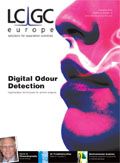
New Study Reviews Chromatography Methods for Flavonoid Analysis
April 21st 2025Flavonoids are widely used metabolites that carry out various functions in different industries, such as food and cosmetics. Detecting, separating, and quantifying them in fruit species can be a complicated process.
Analytical Challenges in Measuring Migration from Food Contact Materials
November 2nd 2015Food contact materials contain low molecular weight additives and processing aids which can migrate into foods leading to trace levels of contamination. Food safety is ensured through regulations, comprising compositional controls and migration limits, which present a significant analytical challenge to the food industry to ensure compliance and demonstrate due diligence. Of the various analytical approaches, LC-MS/MS has proved to be an essential tool in monitoring migration of target compounds into foods, and more sophisticated approaches such as LC-high resolution MS (Orbitrap) are being increasingly used for untargeted analysis to monitor non-intentionally added substances. This podcast will provide an overview to this area, illustrated with various applications showing current approaches being employed.

.png&w=3840&q=75)

.png&w=3840&q=75)



.png&w=3840&q=75)



.png&w=3840&q=75)









